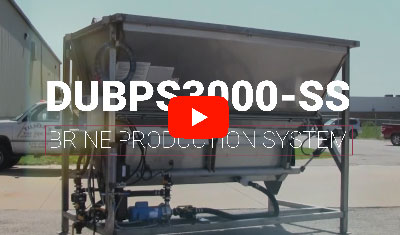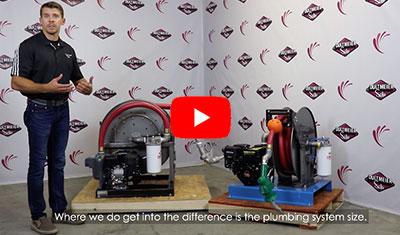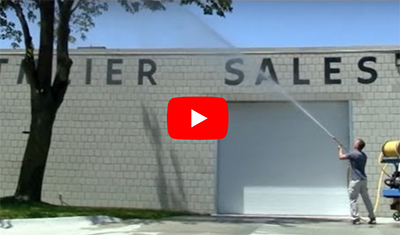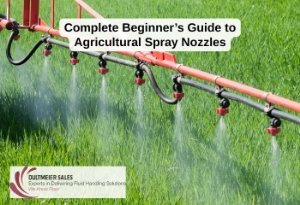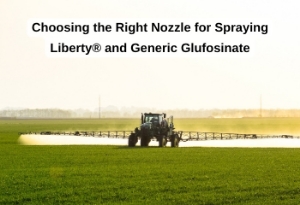What Every Farmer, Turf Pro, and Applicator Needs to Know
Whether you're protecting a soybean field from weeds or applying fungicides on turfgrass, you need the right sprayer nozzle to achieve the results you want. These nozzles may be small, but they control critical factors: the amount of product applied, where it lands, how evenly it's distributed, and the amount of drift that occurs.
When it comes down to it, nozzles are the most important aspect of your sprayer. Choose wrong and you risk wasting product, losing time, and damaging your crop (or even your neighbor’s).
The problem? Sprayer nozzles can be confusing. Between color codes, flow rates, droplet sizes, and dozens of nozzle types, it’s easy to get overwhelmed. That’s the reason for this guide.
Whether you're a farmer dialing in your self-propelled sprayer, a golf pro applying fertilizer to fairways, or a pest control operator looking to reduce drift, this is your complete beginner’s guide to sprayer nozzles. We’ll walk you through the different types of nozzles, sizes, color codes, and droplet ranges so you can confidently select the proper nozzle for your application.
TL;DR: The Complete Beginner’s Guide to Agricultural Sprayer Nozzles
|
Why Nozzles Matter in Spraying
Nozzles control droplet size, spray pattern, and flow rate — all of which directly affect coverage and application accuracy. Here’s what each factor means and why it’s important.
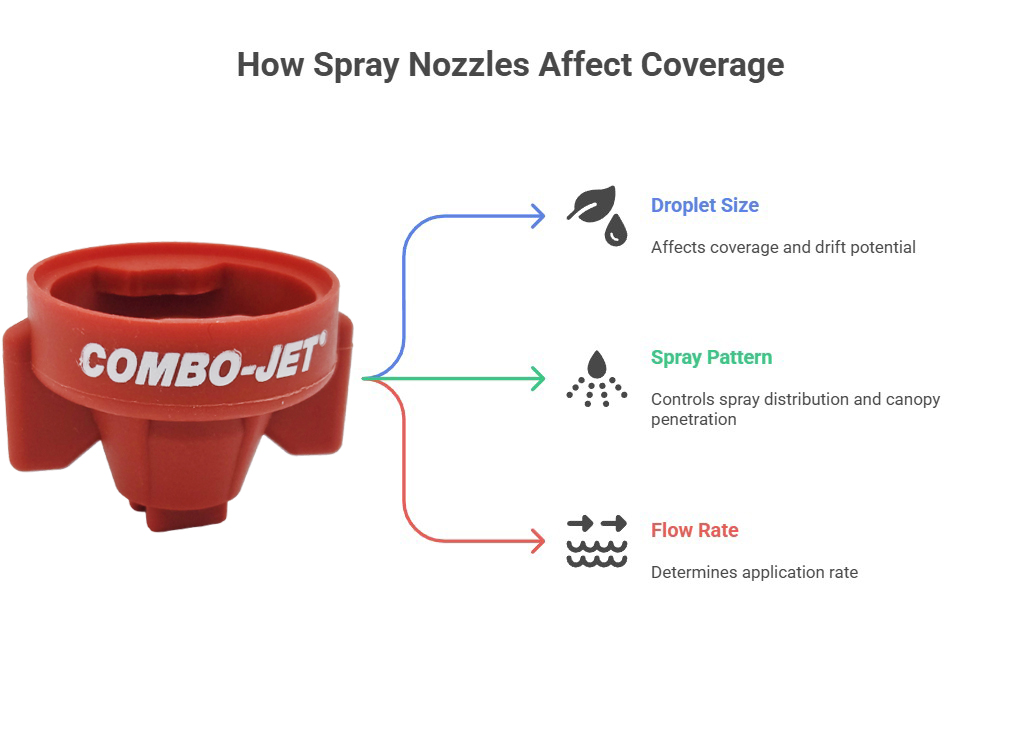
How Nozzles Impact Spraying Performance:
- Droplet Size: This determines how the spray behaves in the air and its ability to hit the intended target. Smaller droplets provide better surface coverage and penetration, but are more prone to drift. Larger droplets resist drift but may offer less contact coverage.
- Spray Pattern: Whether it’s a flat fan, cone, or stream style nozzle, the pattern controls where and how the spray is distributed — critical to ensure proper overlap between each nozzle and offer canopy penetration in dense crops.
- Flow Rate (GPM): The nozzle's size determines how much liquid passes through it at a given pressure, which determines exactly how much product that nozzle can apply in terms of a gallon per acre rate. This is key to applying the correct application rate.
Bottom line: Your coverage is a result of droplet size, pattern, flow rate, and operating conditions. If one single factor is out of line, it can lead to missed targets, wasted product, or ineffective results — driving up costs and reducing effectiveness. Nozzles ultimately determine if your sprayer gets the job done. The sprayer pump, hose, strainer, GPS, or even your rate controller do not impact the sprayer's ability to eliminate pests and prevent crop damage as much as the nozzles.
So with this in mind, let's get you up to speed with the finer details of sprayer nozzles.
Nozzles vs. Tips – What’s the Difference?
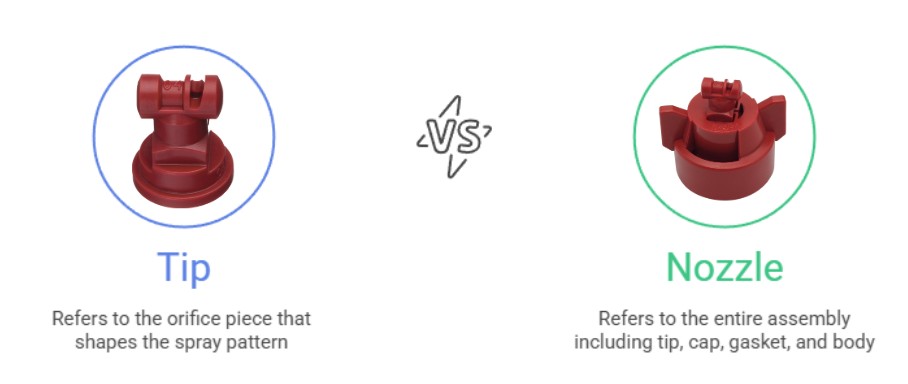
To avoid confusion, it is necessary to define exactly what we mean when referring to sprayer nozzles. In sprayer terminology, “nozzle” and “tip” are often used interchangeably—but there’s a subtle distinction:
- Tip typically refers to the part of the nozzle assembly that shapes and directs the spray pattern (the orifice piece).
- Nozzle can refer to the entire assembly—which may include the tip, cap, gasket, and nozzle body.
Many users and manufacturers casually use “nozzle” to mean just the spray tip.
Anatomy of a Spray Nozzle
Spray nozzles come in a wide variety of styles, but most share a basic design: a tip (or orifice) that shapes the spray, a cap that secures the tip, and a nozzle body that connects the assembly to the boom or wand.
The cap threads or twists onto the nozzle body, holding the tip in place while allowing for easy removal and replacement. Some nozzles are one-piece designs, with the tip and cap molded together for convenience.
How Nozzles Attach to the Boom
The nozzle body mounts directly to the spray boom or wand and serves as the base for the nozzle assembly. Most bodies use either a threaded connection (like 11/16" nozzle body thread) or a quick-attach system with twist-lock tabs.
In threaded systems, the cap screws onto the nozzle body. In quick-attach systems, the cap locks in place with a quarter-turn, making swaps fast and tool-free.
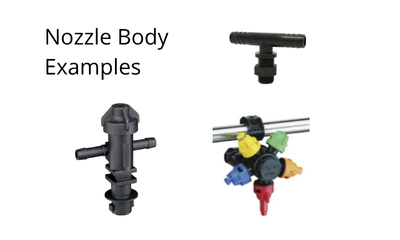
The type of nozzle body used depends on boom design, nozzle spacing, and your sprayer setup. There are nearly as many body styles as there are nozzles, so compatibility matters.
Overview of key nozzle components
Flat fan nozzles for boom sprayers typically include a tip, cap, and gasket.
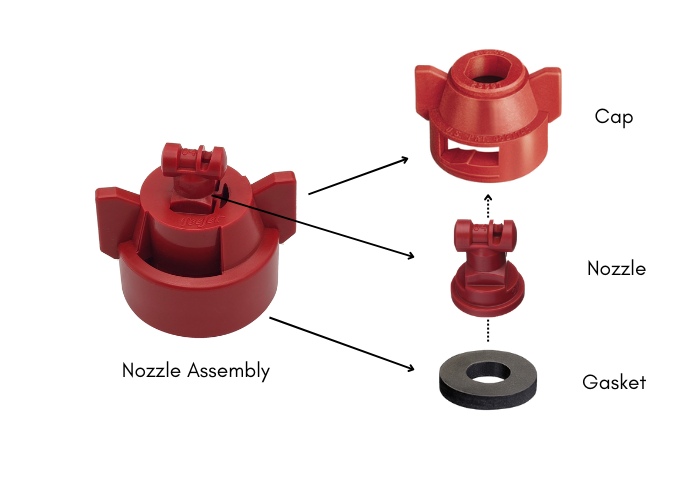
Some manufacturers offer integrated designs like Wilger’s molded one-piece nozzles, combining cap and tip.
.jpg)
In addition to boom sprayer nozzles, there are one-piece nozzles for use on sprayer wands:
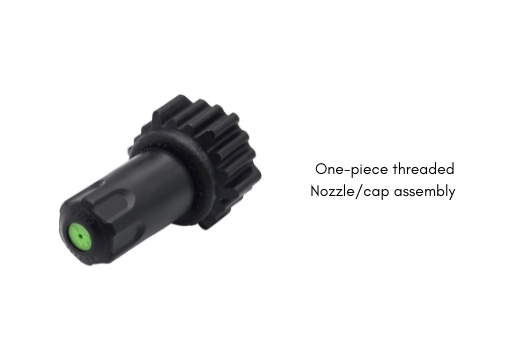
Further complicating the matter, there are any number of specialty nozzles, orifice plates, boomless nozzles, and flood nozzles that may require adapters and other accessories. We don’t have room on this page to cover all the variations, but if you need assistance adapting spray nozzles to a sprayer, reach out to our staff. They are experienced and have hundreds of nozzle adapters at their disposal.
Spray Nozzle Patterns
A sprayer nozzle pattern refers to the shape and distribution of the fluid as it exits the nozzle. There are several different types with subtle variations within each one. As you will find in the spray nozzle world, subtle differences can result in a substantially different output or application.
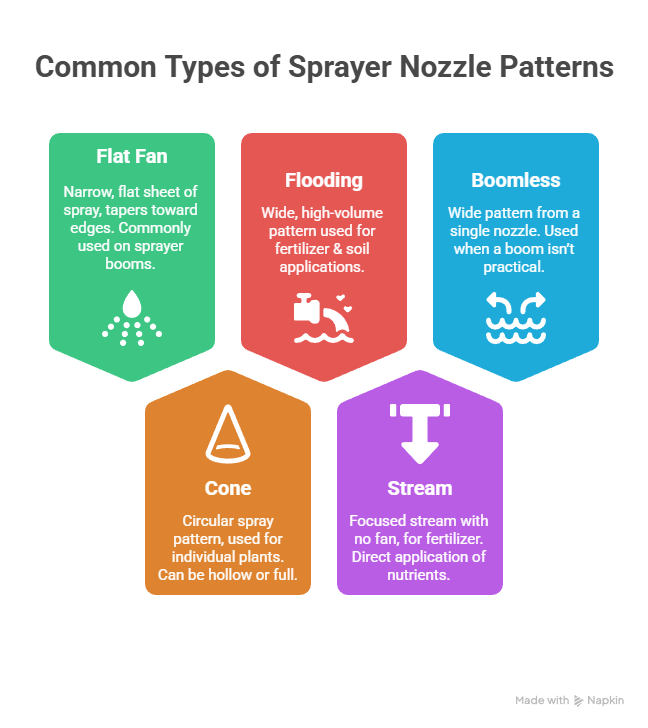
Pattern affects how the nozzle needs to be spaced, the drift reduction capability, the penetration, how your application rate is determined, and more. Here are the common sprayer nozzle types:
- Flat Fan – Narrow, flat sheet of spray that tapers toward the edges of the fan—commonly used on sprayer booms spaced at intervals to allow the fans to overlap.
- Cone (Hollow and Full) – Circular spray—used for coverage of individual plants or targeted areas.
- Flooding – for drift reduction; fertilizer and soil-applied applications.
- Stream/Jet: Focused stream with no fan—used for fertilizer application
- Boomless: Wide pattern from a single nozzle—used when a boom isn’t practical.
Spray angle is an important aspect of a spray nozzle's pattern. As I mentioned above, there are slight variations of pattern within each pattern family. For example, flat fan nozzles can have spray patterns that produce 80, 110, 120 degree fans or others. Spray angle affects the coverage at different boom heights and spacing.
There is a lot more to each nozzle type, including how they should be spaced, the coverage they offer, etc. You can learn more in our complete guide to spray nozzles and the patterns they produce. It explains how the patterns affect coverage and how to select the correct type for your needs.
Droplet Size
One of the most important—and often overlooked—aspects of spray application is droplet size. The size of the droplets dispersed by a spray tip is a major factor in coverage, canopy penetration, and drift.
What Are Droplet Sizes?
Sprayer nozzles break liquid into droplets as the spray exits the tip. These droplets vary in size, typically measured in microns (µm). (For reference, a human hair is about 70 microns wide.)
Spray droplet sizes are grouped into categories based on standards set by agricultural engineering organizations. These classifications help applicators choose the right droplet size for effective coverage, drift control, and compliance with pesticide labels. By following these guidelines, users can make informed decisions about nozzle selection and spraying practices to get the best results in the field.
Droplet Size Categories

Droplets are categorized into different size categories ranging from Very Fine to Ultra Coarse. The smaller droplets will generally result in better coverage but are susceptible to drift. The larger the droplet, the less drift, but there is less surface coverage.
Generally speaking, finer droplets are good for contact herbicides while coarser droplets are good for systemic herbicides and less effective for contact sprays. If you want to go deeper into nozzle droplet size, then be sure to read this article that provides a lot more detail.
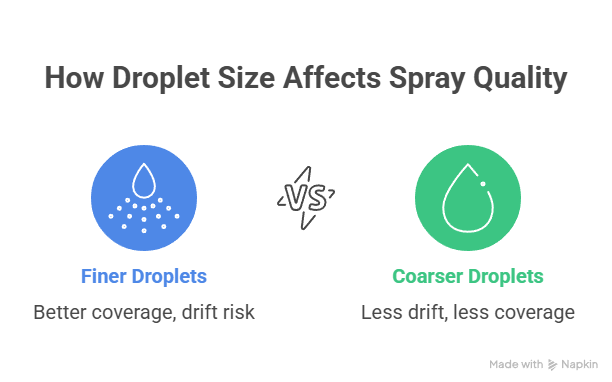
Nozzle Color Codes and Sizing
They may seem insignificant, but the numbers and letters printed on them carry a lot of important information. Typically, the numbers will indicate the nozzle flow rate and spray pattern angle. For flat fan nozzles, these codes are based on an international standard (ISO 10625), and once you understand how to read them, picking the right nozzle becomes much easier.
What the Numbers Mean
The numbers on a nozzle refer to the spray angle and the capacity or flow rate. The first group of numbers tells you the angle in degrees of the fan or cone. The second group of numbers will tell you the flow rate of the nozzle.
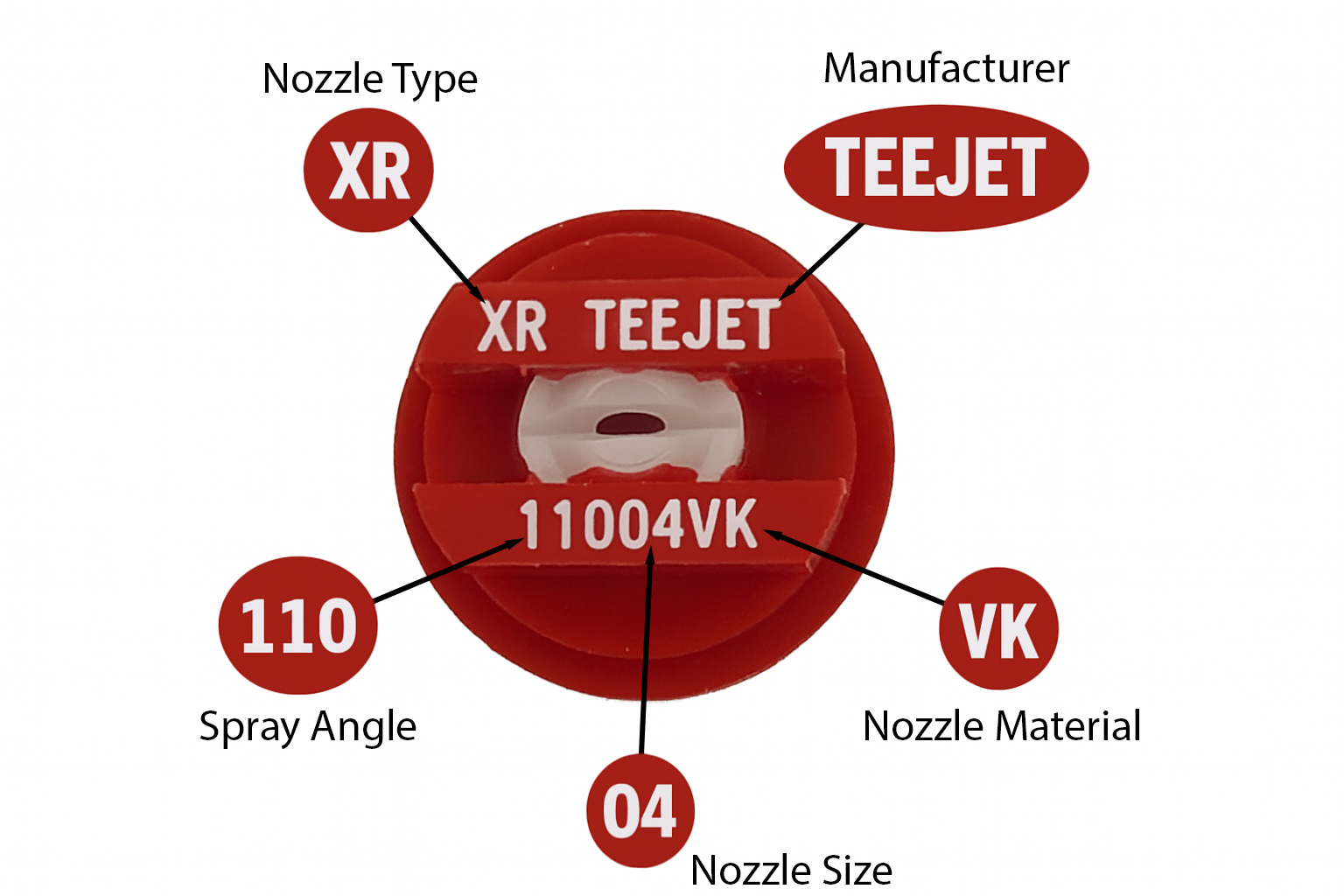
There may also be letters on your spray nozzle. These can refer to different things. In many cases, they will indicate the nozzle type/series, the nozzle material, and the manufacturer.
Color Matters Too
The color of the nozzle will also tell you the flow rate. Thanks to ISO color coding, nozzle color indicates flow rate, regardless of the brand. This makes it easy to match or replace nozzles just by looking at the color and number together.
Not all types of nozzles fit this code, but the vast majority of flat fan, dual fan, and cone nozzles used on boom sprayers will follow this code. For more details, read our full guide to understanding nozzle numbers and coloring. It walks through examples and has charts showing the color/sizing code.
Selecting a Sprayer Nozzle
Choosing the right spray nozzle starts with understanding your specific application. Ask yourself: what pest are you targeting, where is it located, when and how are you applying, and what chemical are you using? These answers will guide your nozzle selection.
- Always Refer to the Pesticide Label
The label provides crucial guidance — including application rates, recommended nozzle types, droplet size, pressure, and legal requirements. It's not optional: the label is the law. - Match the Nozzle to What You’re Spraying
Different products call for different tips. Herbicides usually work best with flat fan nozzles, fertilizers often need stream or flood tips, and fungicides may require finer coverage. Also, check material compatibility — stainless steel, ceramic, acetal, or polypropylene tips may perform differently depending on the chemical. - Consider Your Application Method
Boom spacing, spray pattern, and operating pressure all influence nozzle choice. Most row crop sprayers use 110° flat fan nozzles at 15" or 20" spacing, while wider spacing or drift-sensitive applications may need specialty nozzles. - Evaluate Drift Potential
Drift reduces effectiveness and increases risk to neighboring crops. Air-induction nozzles reduce drift by producing larger droplets. Your product label and nozzle charts will help you choose the correct droplet size and PSI range.
In short, nozzle selection isn’t one-size-fits-all. You must consider the right questions and refer to the pesticide or fertilizer label. This way you can find the nozzle that delivers accurate, effective, and compliant application.
We created a free tool that helps you walk through various factors and provide you with spray nozzle options that will meet your needs. This tool is a great starting point but you can always reach out with any questions.
>Try out the nozzle Selector tool here!
Sizing Your Spray Nozzle
Choosing the correct sprayer nozzle size is a vital part of the nozzle selection process. After you know the nozzle type you need. We need to calculate the proper size. Nozzle size refers to the flow capacity in GPM at certain pressure.
The size you need is determined by your travel speed, nozzle spacing, and application rate (typically gallons per acre). When sizing your nozzle, you will need these three key pieces of info:
- GPA (Gallons Per Acre) – Your desired application rate
- MPH (Sprayer Speed) – Your average spraying speed
- Nozzle Spacing – The distance between nozzles on your boom (commonly 15” or 20")
This info is entered into this formula below and will provide the flow rate needed per nozzle:
GPA × MPH × Nozzle Spacing ÷ 5,940 = GPM per nozzle
You can learn more about using this formula in our guide to sizing spray nozzles. It provides examples and explains more of the nuance. You can also use our nozzle sizing calculator to find out what nozzle size you need at various speeds and application rates:
Spray Nozzle Charts
Once you know the nozzle type and the size required, you must identify the nozzle size that will allow you to hit your target rate. This means understanding how to read a spray nozzle chart. These charts give you the key performance details for each nozzle—helping you match the right size and type to your application.
What You’ll Find on a Nozzle Chart
- Flow Rate (GPM): How much liquid the nozzle puts out per minute at different pressures.
- Operating Pressure (PSI): The pressure range where the nozzle performs properly.
- Droplet Size: Spray quality category (Fine, Medium, Coarse, etc.) at different pressures.
- Application Rate (GPA): Gallons per acre based on nozzle spacing and travel speed.
These numbers help you select a nozzle that applies the right amount of product, at the right pressure, and with the right droplet size for the coverage you need and drift control required
If you are new to nozzle charts and want to see more details, this guide will walk you through how to use a spray nozzle chart.
Nozzle Calibration, Wear & Maintenance
Even the perfect nozzle can deliver poor results if it’s not properly maintained or calibrated. Over time, nozzles wear out, affecting flow rate, droplet size, and overall spray performance. To stay effective—and compliant—you need to regularly check your nozzles and make sure they’re doing what they’re supposed to do.
Why Calibration Matters
Calibration ensures your nozzles are applying the right amount of product at the correct rate and pressure. Even small deviations in flow can mean overapplying or underapplying, which wastes product and reduces effectiveness. You should calibrate your sprayer every season—or anytime you switch products, change speeds, or adjust boom settings.
A simple way to check flow rate is to measure how much liquid each nozzle outputs over a fixed time and compare it to the nozzle chart. If it’s off by more than 10% from the expected rate, it’s time to clean or replace that nozzle.
How to Spot Nozzle Wear
Nozzles wear gradually, especially with abrasive fertilizers or pesticides. Worn nozzles often show signs like:
- Uneven spray patterns
- Excessive drift or misting
- Reduced or increased flow rate
- Visual damage or erosion on the orifice
It’s a good idea to keep a few new nozzles on hand for comparison. If the output or pattern from a used nozzle doesn't match the new one, it's likely worn and needs to be replaced.
Cleaning & Maintenance Tips
- Avoid wire brushes or hard objects that could damage the orifice.
- Use soft brushes or manufacturer-approved nozzle cleaning tools.
- Flush your sprayer system with clean water after each use to prevent chemical buildup.
- Inspect gaskets and caps for cracks or leaks during each cleanout.
Neglecting nozzle maintenance can lead to poor results—even with the right size, type, and pressure. A little time spent checking, cleaning, and replacing worn nozzles goes a long way in protecting your crop and your bottom line.
Final Word
Spray nozzles may be small, but they play one of the biggest roles in your sprayer’s performance. From selecting the right type and size to understanding spray patterns, droplet sizes, and application rates—every detail matters.
By taking the time to learn how nozzles work, how to read charts, and how to maintain them, you’ll get better results in the field, reduce waste, and stay compliant with product labels. Whether you're just getting started or fine-tuning your setup, understanding your nozzles is the key to better spraying.

